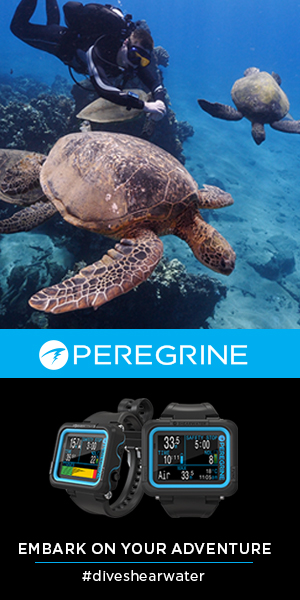The only glow-in-the-dark creature familiar to most of us is the lightning bug. A few other land creatures, such as glow worms and types of mushrooms also shine in the dark. This phenomenon is known as bioluminescence. Although rare among land animals, bioluminescence is widespread in the marine environment. Along with bacteria and algae, nearly every major group of marine animals has members that glow.
You do not have to be a diver to see ocean creatures glowing in the dark. Bahia Fosforescente in Puerto Rico is well-known for its frequent night light shows. Boats zoom across the bay, leaving wakes of glowing green rivers. Microscopic organisms known as dinoflagellates cause this eerie event. When disturbed, each individual gives off a brief flash of light. Where dinoflagellates are abundant, billions of individual flashes yield brilliant results. In other areas of the ocean, brilliant light shows are less regular, as the concentration of dinoflagellates varies with the seasons.
The tiny flashes of bioluminescence made by dinoflagellates result from a chemical process inside their cells. The enzyme luciferase allows molecules of oxygen and luciferin to combine. In the process, light is given off. This luminescent light is different from the light we normally see.
The light we normally see is “hot” light. Light emitted from incandescent bulbs or the sun results from the glowing of objects (or gases) brought up to very high temperatures. Bioluminescent light is “cold” light. With bioluminescence, most of the cell’s energy goes into producing light, not heat.
With its small heat loss, bioluminescence is the most efficient method of light production known. The cell releases less than 1 percent of its energy as heat during bioluminescence. Compare this to other cell activities, which typically result in a 60 percent energy loss as heat, or to combustion in a gasoline engine, which results in a 75 percent energy loss as heat.
The dinoflagellates most commonly found in glowing surface water include Noctiluca (Latin: night light), Pyrocystis (Greek: fire bag), Peridium, Gonyaulax, and Gymnodinium. Gonyaulax is also responsible for causing certain red tides. Thus, these creatures cause a red tint by day and a bluish-green glow by night. Comb jellies, copepods, and jellyfish also add to surface water luminescence.
The Caribbean brittle star Ophiopsila riisei lives along the reef crest, fore-reef slope, and coral rubble. Look for “hairy” coral where groups of these brittle stars extend their 6-inch (15-cm) arms. They may be difficult to find because they are quick to retract their arms when flashlights shine on them. However, when touched, you will find they glow with an intense luminescence. In much the same way that birds learn not to eat the boldly colored, foul-tasting monarch butterfly, predatory crabs learn not to eat this glowing brittle star. A nip to the body causes Ophiopsila to flash, and its flesh leaves a bad taste in the mouth of its predator. Ultimately, future flashes are enough to warn the crabs not to take a bite.
Scuba diving has led to greater understanding of a few bioluminescent fish found in shallow water. The pinecone fish (Monocentris) lives in the Indian and Pacific oceans. Divers have observed that it uses a bioluminescent spot on the tip of its lower lip to lure prey. The glowing spot is a symbiotic group of bioluminescent bacteria that live in a special light organ called a photophore. Luminescent bacteria produce a constant glow that the fish cannot turn on and off at will. However, the pinecone fish can hide its light by tucking it under its upper lip.
Commonly seen by divers in the Red Sea is the flashlight fish (Photoblepharon palpebratus). Found in caves, its light is visible for 100 feet (30 m).
Like the pinecone fish, flashlight fish do not make their own light. They store luminescent bacteria in light organs beneath their eyes. They use the lights as beacons to both find and lure prey. To avoid their own predators, flashlight fish are able to cover the light organ with an eyelid and then swim away. The fish can repeat the blink-and-run escape behavior as many as 75 times per minute. When many fish in the group start flashing, the extra lights confuse the predator even more.
Most marine bioluminescence is in the blue and green ranges of color. These colors are the wavelengths of light that best penetrate sea water. However, other bioluminescent colors have also evolved among marine creatures, especially those in deeper water. These colors include red, pink, yellow, violet, and white light.
Luminescence among shallow-water fishes is limited, but many mid-water and deep-sea animals (see “The Deep-Sea,” Dive Training, June 1997) exhibit glowing lights. A wide diversity of bioluminescent functions takes place within these groups. Some of the most interesting functions lie within the realm of disguise and detection.
Light from the surface, although dim, can outline the bodies of mid-water fish. So to avoid detection, many mid-water dwellers have luminescent bellies. They camouflage themselves by matching their belly lights with the intensity of light from above. Unfortunately, this clever deception is only a thin disguise to some predators. The hatchet fish is equipped with a special yellow eye filter that allows it to easily detect blue-green luminescent bellies.
Most of the fishes who produce bioluminescence in the blue and green ranges see these colors. However, they may not see red light. The fishes Aristomias, Pachystomias, and Malacosteus use this to their advantage. First, their eyes can detect red light, and second, they emit red light by which to hunt. Their red hunting lights are invisible to their prey.
Many sea creatures, such as prawns, are red. Red light absorbs rather than reflects green and blue light. As a result, this renders them invisible to predators hunting with blue or green lights. However, under the red light of Pachystomias, red prawns light up brightly and become easy prey.
Glow-in-the-Dark Diving
The best opportunities for viewing bioluminescent phenomena exist at night. If possible, select a shallow site that offers a sandy area where you can kneel. Make sure you are weighted properly so you can easily achieve negative buoyancy.
Cover your dive light to allow near-total darkness. Wait just a moment for your eyes to adjust to the darkness, then wave your hand to agitate the floating dinoflagellates. You’ll see tiny flashes, like trails of fairy dust, as you wave your hand. While swimming, you may also notice flashes produced by your buddy’s fin kicks. Of course, the concentration of dinoflagellates present will determine the intensity of the light show. Along rocky ledges, look for ghostly green halos surrounding barnacles as they sweep their feeding tentacles through the water.
You can dive in either warm or cold water as you search for animals that glow. You can search for sea squirts whose colonies reach 10-15 feet (3-5 m) in length and flash with dazzling patterns when irritated. Or hunt for sea pansies and sea pens that also glow when irritated. Look for the Bermuda fireworm (Odontosyllis enopla), who comes to the surface during the few days after a full moon. Swarming females use their luminescent glow to attract males for spawning.
During your safety stop, be on the lookout for drifting warty jellyfish (Pelagia noctiluca) that feed near the surface at night. Their 1-inch (2.5-cm) luminescent bodies provide warning to help you avoid their painful sting.
If you are shore diving, you may have one more chance to see a glow in the darkness. Often, sand fleas become infested with luminescent marine bacteria. As you walk across the shore, look behind you for a trail of glowing footsteps.
Although rare among land animals, bioluminescence is widespread in the marine environment.
Along with bacteria and algae, nearly every major group of marine animals has members that glow.
Bioluminescence vs Phosphorescence
Bioluminescence is sometimes called phosphorescence. However, this is not a correct use of the term. Phosphorescence results when inanimate crystals such as those in dive watches glow. The crystals must first be activated by a light source (or other radiation), then they produce light as the crystals slowly oxidize. Phosphorescence is similar to bioluminescence in that little heat is lost during the chemical reaction.
Bright Lights, Big Mystery
Scientists suggest several hypotheses to explain why dinoflagellates flash when disturbed. One hypothesis indicates that a dinoflagellate flash is brilliant enough to startle and briefly stall its predators, the copepods. An alternative hypothesis suggests that the flash serves to alert and attract the copepods’ enemies. Thus, the copepods get eaten instead of the dinoflagellates. In addition, the organic remains from partially eaten copepods may serve as nutrients for the dinoflagellates.
Some scientists argue that bioluminescence serves no purpose for the dinoflagellate. Instead, they believe it is merely a remnant of evolution. The first dinoflagellates evolved in an environment that lacked oxygen. Later, newly evolved plants produced oxygen as a product of photosynthesis. This free oxygen acted as an irritant or poison to those animals accustomed to living in an oxygen-free environment. Bioluminescence may then have evolved as the cell’s way to consume harmful oxygen. To support the anti-poisoning hypothesis, scientists note that diatoms, who evolved after oxygen was abundant, are not bioluminescent. Other scientists argue that bioluminescence first developed to prevent oxygen poisoning, with the protective functions evolving later.




